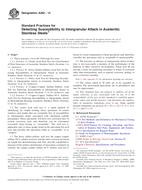Potřebujeme váš souhlas k využití jednotlivých dat, aby se vám mimo jiné mohly ukazovat informace týkající se vašich zájmů. Souhlas udělíte kliknutím na tlačítko „OK“.
ASTM A262-14
Standard Practices for Detecting Susceptibility to Intergranular Attack in Austenitic Stainless Steels
Automaticky přeložený název:
Standardní postupy pro zjišťování náchylnost k mezikrystalové útoku v austenitické korozivzdorné oceli
NORMA vydána dne 1.7.2014
Informace o normě:
Označení normy: ASTM A262-14
Poznámka: NEPLATNÁ
Datum vydání normy: 1.7.2014
Kód zboží: NS-1793
Počet stran: 20
Přibližná hmotnost: 60 g (0.13 liber)
Země: Americká technická norma
Kategorie: Technické normy ASTM
Anotace textu normy ASTM A262-14 :
Keywords:
austenitic stainless steel, copper sulfate, corrosion testing, etch structures, ferric sulfate, intergranular corrosion, nitric acid, oxalic acid, ICS Number Code 77.140.20 (Steels of high quality)
Doplňující informace
| Significance and Use | ||||||||||||||
|
6.1 Use of the etch test allows rapid acceptance of specific lots of material without the need to perform time-consuming and costly hot acid immersion tests on those lots. |
||||||||||||||
| 1. Scope | ||||||||||||||
|
1.1 These practices cover the following five tests: 1.1.1 Practice A—Oxalic Acid Etch Test for Classification of Etch Structures of Austenitic Stainless Steels (Sections 4 to 13, inclusive), 1.1.2 Practice B—Ferric Sulfate-Sulfuric Acid Test for Detecting Susceptibility to Intergranular Attack in Austenitic Stainless Steels (Sections 14 to 25, inclusive), 1.1.3 Practice C—Nitric Acid Test for Detecting Susceptibility to Intergranular Attack in Austenitic Stainless Steels (Sections 26 to 36, inclusive), 1.1.4 Practice E—Copper–Copper Sulfate–Sulfuric Acid Test for Detecting Susceptibility to Intergranular Attack in Austenitic Stainless Steels (Sections 37 to 46, inclusive), and 1.1.5 Practice F—Copper–Copper Sulfate–50 % Sulfuric Acid Test for Detecting Susceptibility to Intergranular Attack in Molybdenum-Bearing Austenitic Stainless Steels (Sections 47 to 58, inclusive). 1.2 The oxalic acid etch test is a rapid method of identifying, by simple etching, those specimens of certain stainless steel grades that are essentially free of susceptibility to intergranular attack associated with chromium carbide precipitates. These specimens will have low corrosion rates in certain corrosion tests and therefore can be eliminated (screened) from testing as “acceptable.” The etch test is applicable only to those grades listed in the individual hot acid tests and classifies the specimens either as “acceptable” or as “suspect.” 1.3 The ferric sulfate-sulfuric acid test, the copper–copper sulfate–50 % sulfuric acid test, and the nitric acid test are based on weight loss determinations and, thus, provide a quantitative measure of the relative performance of specimens evaluated. In contrast, the copper–copper sulfate–16 % sulfuric acid test is based on visual examination of bend specimens and, therefore, classifies the specimens only as acceptable or nonacceptable. 1.4 The presence or absence of intergranular attack in these tests is not necessarily a measure of the performance of the material in other corrosive environments. These tests do not provide a basis for predicting resistance to forms of corrosion other than intergranular, such as general corrosion, pitting, or stress-corrosion cracking. Note 1: See Appendix X1
for information regarding test selection.
1.5 The values stated in SI units are to be regarded as standard. The inch-pound equivalents are in parentheses and may be approximate. 1.6 This standard does not purport to address all of the safety concerns, if any, associated with its use. It is the responsibility of the user of this standard to establish appropriate safety and health practices and determine the applicability of regulatory limitations prior to use. Some specific hazards statements are given in 10.1, 20.1.1, 20.1.9, 31.3, 34.4, 53.1.1, and 53.1.10. |
||||||||||||||
| 2. Referenced Documents | ||||||||||||||
|
Odebírejte informace o nově vydaných normách ZDARMA:
Chcete pravidelně odebírat informace o nově vycházejících normách z celého světa a to zcela zdarma?
Přihlašte se k odběru. Vše je velice jednoduché a absolutně ZDARMA.
Na výběr máte vydavatele z celého světa.




 Cookies
Cookies
